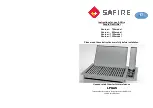
English
19
Putting into operation
Accumulator placing and removal
Insert the accumulator (1) from the rear power tool side into the
guide rail as far as the stop. By pulling the accumulator backwards
make sure that the accumulator is seated properly.
When removing the accumulator (1), press the accumulator
clamps (2) on both sides and by pulling the accumulator back-
wards take it out of the power tool.
Check of accumulator state
The power tool is equipped by the accumulator state indication
panel (9).
When the accumulator is seated in the power tool, press the indica-
tion switch (10a) on the accumulator state indication panel (9). The
indicator (10b) will light, depending on the residual accumulator
capacity (charging).
If the indicator state is
LOW
(discharged accumulator), take the
accumulator out of the machine and let it charge. Max. charging is
indicated by the
HIGH
indicator signal.
Switching-on
By depressing the operating push button (3) and by its holding
you can control speed smoothly. When depressing the push but-
ton switch (3) the LED indicator, serving for lighting the workplace
in front of the tool lamped in the chuck, will go on automatically.
Switching-off
By releasing the operating push button (3). Runout of the spindle
with the chuck is reduced by the activated brake.
Lower speed is suitable for guiding the bolt/screw to the material.
Higher speed is suitable for screwing the bolt/screw into the mate-
rial or for drilling into the material.
Attention!
Long-time use of variable rotating speed is not recommended as
its can result in operating push button damage.
Changed direction of rotation
Direction of rotation is changed by the change over switch of the
sense of rotation (4):
· By pushing from the right to the left – right run.
· By pushing from the left to the right – left run.
· Push button in the interposition – protection from uninten-
tional switching.
Attention!
If you wish to change position of the change over switch, check at
first that the operating push button is released.
Note:
During first use of the device and during the first change of the
sense of rotation a loud click can be heard. It is a normal phenome-
non which cannot be considered any problem.
Speed changing
Speed changing is carried out by the sliding switch (5).
1. low speed:
move the switch towards the chuck
- the block letter “
L
” will appear
2. high speed:
move the switch from the chuck
- the block letter “
H
” will appear
Torque setting
The necessary torque can be set by swiveling the adjusting
ring (6a) towards the relevant symbol.
Screwing
Symbol
1
= min. torque
Symbol
20
= max. torque for screwing
Drilling
Symbol
= max. torque
Setting of drilling /hammer-drilling
By rotating the adjusting ring (6b) to the relevant symbol, you can
set the plain or the hammer-drilling. When the hammer-drilling is
set, you can drill much more effectively into the masonry (common
building materials).
Attention! Selection of the plain/hammer-drilling
mode may be done at power tool rest only!
When hammer-drilling, the drills of adequate design for this meth-
od of drilling shall be used.
Plain drilling
Symbol
= suitable for screwing, drilling into metal,
wood, etc.
Hammer-drilling
Symbol
= suitable for drilling into masonry.
Tool clamping and releasing
By swiveling the clamping chuck sleeve (8), you open and close
the clamping jaws, which the working tool (bit, bit holder, etc.) is
inserted into. The devices are equipped by automatic spindle arrest
(locking) facilitating tool replacement, by using one hand only in
the requested direction.
Maintenance and service
Instructions for device cleaning
Start the motor and blow impurities and dust out of the vent holes
of the device. Use protective goggles for this operation. Clean the
external plastic parts by a wet rag and mild detergent. Though
these parts are made of the materials resistant to solvents,
NEVER
use any solvent.
Instructions for cleaning the charger
Attention! Risk of electric shock. Prior to start han-
dling the charger, disconnect the line plug from the
socket!
Impurities and dust can be removed from external charger surfaces
by a rag or a non-metal brush. Use neither water nor detergents.
Attention! With respect to protection from el. shock
and preservation of the class of protection, all mainte-
nance and service operations requesting jig saw case
removal must be performed by the authorized service centre
only!
The current list of authorized service centres can be found at our
website
www.narex.cz
, section
“Service Centres”
.
Accessories
The accessories recommended for use with this device are availa-
ble commercially in the shops with hand el. tools.
Storage
The packed device can be stored in a dry unheated store room
where the temperature does not drop below –5 °C.
Store the unpacked device in a dry store room where the temper-
ature does not drop below +5 °C and where abrupt temperature
changes are prevented.
Environmental protection
El. tools, accessories and packaging should be collected for sub-
sequent recovery, recycling and environmentally sound disposal.
For EU countries only:
Do not dispose the el. tools as the home waste!
In conformity with the European Directive 2002/96/EC on waste
electrical and electronic equipment and its implementation in
national legislations the unusable dismantled el. tools should be
collected for subsequent recovery, recycling and environmentally
sound disposal.
Содержание ASP 14-2A
Страница 3: ...3...
Страница 5: ...5 2 1 2 1 2 1 3 4 5 6a 6a 6b 6b 7 8 9 10a 10b 11 12 13...
Страница 26: ...26 1 2 a RCD RCD 3 a 4 a 5 a...
Страница 42: ...42...
Страница 43: ...43...
















































